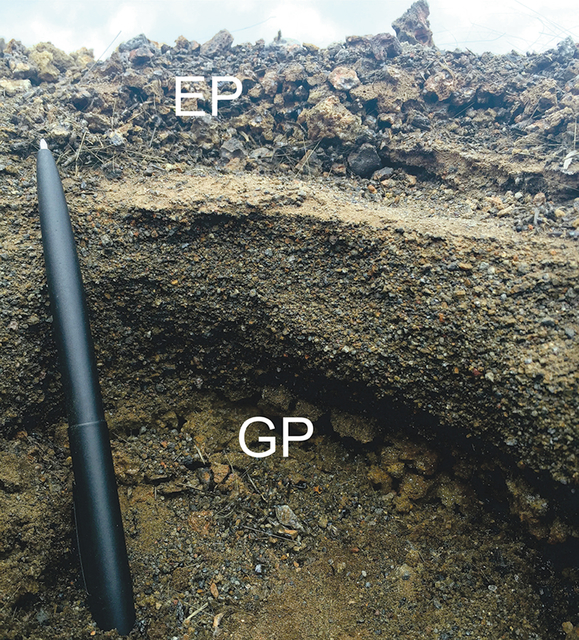Volcano Watch: An assumption about Kilauea Volcano is proven wrong
Everyone extrapolates facts and makes assumptions based on those facts. Sometimes, such an assumption is repeated so often it takes on the aura of a “fact.” This is the story of how one such assumption about Kilauea’s recent past was proven wrong — and only in the past couple of months.
ADVERTISING
Scattered remnants of a once-extensive pumice deposit occur on the ground surface west of Kilauea’s summit caldera. The pumice, known as golden pumice, records a large lava fountain in the southwest part of the caldera.
William Ellis, leader of the first missionaries to visit Kilauea, described numerous pieces of wind-blown pumice (“spumous lava …as light as a sponge”) in hollows on the ground as he approached the summit from the southwest Aug. 1, 1823. This must be the golden pumice. How long before his visit did the pumice fall?
In a study of the golden pumice published in 1987, three celebrated geologists — Bob Sharp (CalTech), Dan Dzurisin (USGS) and Mike Malin (Arizona State) — suggested an eruption date “possibly around 1820.” The only rocks that fell later onto the pumice were, in their interpretation, erupted in 1924. They observed other thin deposits locally overlying (hence, younger than) the golden pumice but ascribed them to remobilization of older deposits by water rather than to younger eruptions.
These observations and interpretations led to the assumption — challenged in this Volcano Watch — that the golden pumice represents the youngest explosive eruption from the caldera until 1924.
Several years ago, another pumice bed, called the eastern pumice, was discovered in the southern part of Kilauea’s caldera. It underlies, and therefore is older than, explosion deposits consisting largely of rock fragments, not pumice.
Work on the eastern pumice — see Volcano Watch for Aug. 8, 2013 (http://hvo.wr.usgs.gov/volcanowatch/view.php?id=188) — tracked it westward into golden pumice country. Nowhere, however, could we find the two deposits in the same outcrop, so we could not determine if the golden pumice was truly younger than the eastern pumice, as was assumed.
The eastern and golden pumices have different chemical signatures, as determined by University of Hawaii at Manoa colleagues. In late September 2016, we were reexamining one outcrop of pumice that looked like eastern pumice but had the composition of golden pumice when, BINGO!
We looked in just the right place and found clear physical evidence of two pumice layers, one on top of the other. The older, lower pumice has the golden pumice composition. A chemical analysis of the younger, upper pumice, which looks physically like eastern pumice, was completed in late October, and it is indeed eastern pumice. The outcrop was examined once more in November with neutral observers, just to be sure, and the field relations were confirmed.
This discovery upsets the apple cart. The assumption is wrong that the golden pumice records the last 19th-century explosion.
Instead, the eastern pumice and at least four other explosions occurred later. The fallout from these explosions was directed mainly southward, rather than westward, so there is little overlap with the golden pumice. But there is just enough, as shown by that one outcrop, to prove the case and falsify the long-held assumption.
Now, we are challenged to determine better the ages of these eruptions. Did they all take place before Ellis arrived, or were some explosions in the later 1820s overlooked because of infrequent visitation to Kilauea? Do some of the rocks overlying the golden pumice, interpreted as reworked older deposits by Sharp and colleagues, instead record younger explosions? Could some of the rocks thought to be of 1924 vintage really be from the early 19th century?
These and other questions await answers. A geologist’s work is never done.
Volcano activity updates
Kilauea continues to erupt at its summit and East Rift Zone. This past week, the summit lava lake level varied between about 7.5 and 20 m (25 and 66 ft) below the vent rim. The 61g lava flow continued to enter the ocean near Kamokuna. On Nov. 21, a new breakout from the upper part of the 61g tube on the flank of Pu‘u ‘O‘o sent surface flows to the east and south. These flows remained active as of Nov. 23. The 61g lava flows do not pose an immediate threat to nearby communities.
Mauna Loa is not erupting. During the past week, small (less than magnitude-3) earthquakes occurred primarily beneath the upper Southwest Rift Zone and summit caldera at depths less than 5 km (3 mi). Deformation related to inflation of a magma reservoir beneath the summit and upper Southwest Rift Zone continues, with inflation occurring mainly in the southwestern part of the magma storage complex.
No earthquakes were recently reported felt on the Big Island.
Visit the HVO website (http://hvo.wr.usgs.gov) for past Volcano Watch articles, Kilauea daily eruption updates, Mauna Loa weekly updates, volcano photos, recent earthquakes info, and more; call for summary updates at 808-967-8862 (Kilauea) or 808-967-8866 (Mauna Loa); email questions to askHVO@usgs.gov.
Volcano Watch (http://hvo.wr.usgs.gov/volcanowatch/) is a weekly article and activity update written by U.S. Geological Survey Hawaiian Volcano Observatory scientists and affiliates.


